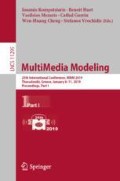Abstract
The human visual system has the ability to adapt to various lighting conditions. In this work, we simulate the dark adaptation process using a custom virtual reality framework. The high dynamic range (HDR) image is rendered, tone mapped and displayed in the head-mounted-display (HMD) equipped with the eye tracker. Observer’s adaptation state is predicted by analysing the HDR image in the surrounding of his/her gaze point. This state is applied during tone mapping to simulate how an observer would see the whole scene being adapted to an arbitrary luminance level. We take into account the spatial extent of the visual adaptation, loss of colour vision, and time course of adaptation. Our main goal is to mimic the adaptation process naturally implemented by the human visual system. However, we prove in the psychophysical experiments that people prefer shorter adaptation while watching a virtual environment. We also justify that a complex perceptual model of adaptation to dark can be replaced with simpler linear formulas.
Access this chapter
Tax calculation will be finalised at checkout
Purchases are for personal use only
References
Palmer, S.E.: Vision Science: Photons to Phenomenology, vol. 1. MIT press, Cambridge (1999)
Reinhard, E., Heidrich, W., Debevec, P., Pattanaik, S., Ward, G., Myszkowski, K.: High Dynamic Range Imaging: Acquisition, Display, and Image-Based Lighting, 2nd edn. Morgan Kaufmann, Amsterdam (2010)
Davson, H.: Physiology of the Eye. Elsevier, Amsterdam (2012)
Graham, C.H.: Vision and Visual Perception. Wiley, Hoboken (1965)
Vangorp, P., Myszkowski, K., Graf, E.W., Mantiuk, R.K.: A model of local adaptation. ACM Trans. Graph. 34, 166:1–166:13 (2015). Proceedings of ACM SIGGRAPH Asia
Mantiuk, R., Markowski, M.: Gaze-dependent tone mapping. In: Kamel, M., Campilho, A. (eds.) ICIAR 2013. LNCS, vol. 7950, pp. 426–433. Springer, Heidelberg (2013). https://doi.org/10.1007/978-3-642-39094-4_48
Ward, G.: A contrast-based scalefactor for luminance display. In: Graphics Gems IV, pp. 415–421 (1994)
Ferwerda, J.A., Pattanaik, S.N., Shirley, P., Greenberg, D.P.: A model of visual adaptation for realistic image synthesis. In: Proceedings of the 23rd Annual Conference on Computer Graphics and Interactive Techniques, pp. 249–258. ACM (1996)
Hunt, R.W.G.: The Reproduction of Colour. Wiley, Hoboken (2005)
Krawczyk, G., Myszkowski, K., Seidel, H.: Perceptual effects in real-time tone mapping. In: Proceedings of the 21st Spring Conference on Computer Graphics, Budmerice, Slovakia, pp. 195–202 (2005)
Peli, E., Yang, J., Goldstein, R.B.: Image invariance with changes in size: the role of peripheral contrast thresholds. JOSA A 8, 1762–1774 (1991)
Mantiuk, R., Janus, S.: Gaze-dependent ambient occlusion. In: Bebis, G., et al. (eds.) ISVC 2012. LNCS, vol. 7431, pp. 523–532. Springer, Heidelberg (2012). https://doi.org/10.1007/978-3-642-33179-4_50
Loschky, L., McConkie, G., Yang, J., Miller, M.: The limits of visual resolution in natural scene viewing. Vis. Cogn. 12, 1057–1092 (2005)
Hecht, S.: Vision: II. The Nature of the Photoreceptor Process, Clark University Press, USA (1934)
Woodworth, R.S., Schlosberg, H., Kling, J.W., Riggs, L.A.: Woodworth & Schlosberg’s Experimental Psychology, 3rd edn. Holt, Rinehart and Winston, Houghton (1971)
Mantiuk, R.K., Tomaszewska, A., Mantiuk, R.: Comparison of four subjective methods for image quality assessment. Comput. Graph. Forum 31, 2478–2491 (2012)
Author information
Authors and Affiliations
Corresponding author
Editor information
Editors and Affiliations
Rights and permissions
Copyright information
© 2019 Springer Nature Switzerland AG
About this paper
Cite this paper
Wernikowski, M., Mantiuk, R., Piórkowski, R. (2019). Preferred Model of Adaptation to Dark for Virtual Reality Headsets. In: Kompatsiaris, I., Huet, B., Mezaris, V., Gurrin, C., Cheng, WH., Vrochidis, S. (eds) MultiMedia Modeling. MMM 2019. Lecture Notes in Computer Science(), vol 11295. Springer, Cham. https://doi.org/10.1007/978-3-030-05710-7_10
Download citation
DOI: https://doi.org/10.1007/978-3-030-05710-7_10
Published:
Publisher Name: Springer, Cham
Print ISBN: 978-3-030-05709-1
Online ISBN: 978-3-030-05710-7
eBook Packages: Computer ScienceComputer Science (R0)

